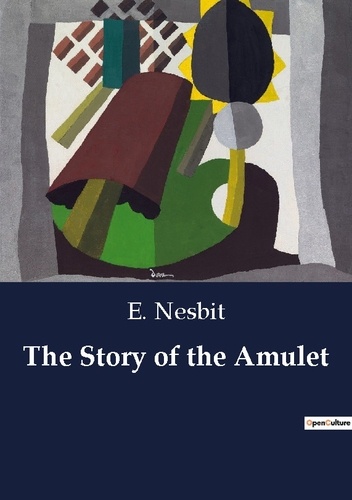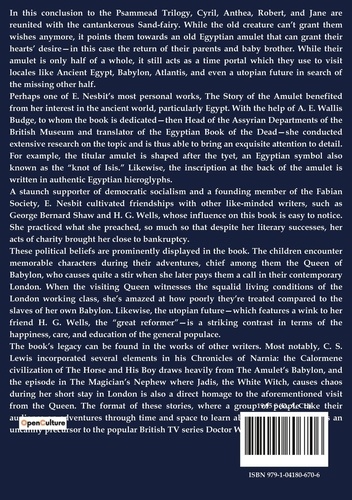En cours de chargement...
In this conclusion to the Psammead Trilogy, Cyril, Anthea, Robert, and Jane are reunited with the cantankerous Sand-fairy. While the old creature can't grant them wishes anymore, it points them towards an old Egyptian amulet that can grant their hearts' desire-in this case the return of their parents and baby brother. While their amulet is only half of a whole, it still acts as a time portal which they use to visit locales like Ancient Egypt, Babylon, Atlantis, and even a utopian future in search of the missing other half.
Perhaps one of E. Nesbit's most personal works, The Story of the Amulet benefited from her interest in the ancient world, particularly Egypt. With the help of A. E. Wallis Budge, to whom the book is dedicated-then Head of the Assyrian Departments of the British Museum and translator of the Egyptian Book of the Dead-she conducted extensive research on the topic and is thus able to bring an exquisite attention to detail.
For example, the titular amulet is shaped after the tyet, an Egyptian symbol also known as the "knot of Isis. " Likewise, the inscription at the back of the amulet is written in authentic Egyptian hieroglyphs. A staunch supporter of democratic socialism and a founding member of the Fabian Society, E. Nesbit cultivated friendships with other like-minded writers, such as George Bernard Shaw and H. G.
Wells, whose influence on this book is easy to notice. She practiced what she preached, so much so that despite her literary successes, her acts of charity brought her close to bankruptcy. These political beliefs are prominently displayed in the book. The children encounter memorable characters during their adventures, chief among them the Queen of Babylon, who causes quite a stir when she later pays them a call in their contemporary London.
When the visiting Queen witnesses the squalid living conditions of the London working class, she's amazed at how poorly they're treated compared to the slaves of her own Babylon. Likewise, the utopian future-which features a wink to her friend H. G. Wells, the "great reformer"-is a striking contrast in terms of the happiness, care, and education of the general populace. The book's legacy can be found in the works of other writers.
Most notably, C. S. Lewis incorporated several elements in his Chronicles of Narnia : the Calormene civilization of The Horse and His Boy draws heavily from The Amulet's Babylon, and the episode in The Magician's Nephew where Jadis, the White Witch, causes chaos during her short stay in London is also a direct homage to the aforementioned visit from the Queen. The format of these stories, where a group of people take their audience on adventures through time and space to learn about distant cultures, is an uncanny precursor to the popular British TV series Doctor Who.




